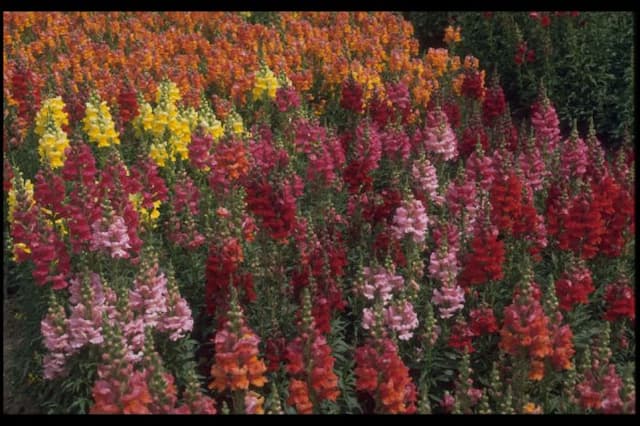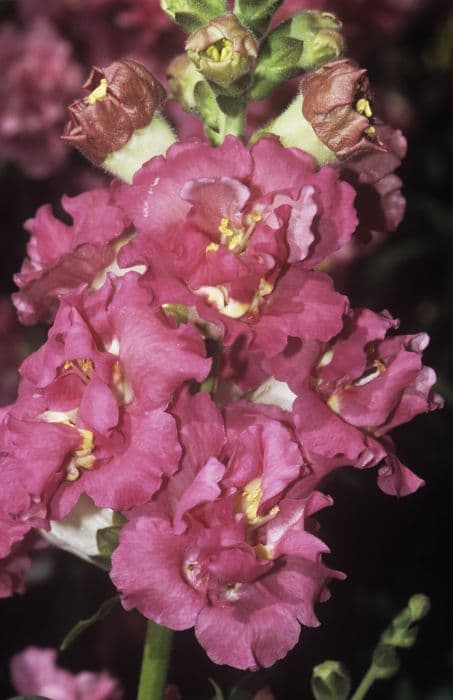Beardtongue Penstemon 'Drinkstone Red'

ABOUT
Penstemon 'Drinkstone Red' is a striking perennial plant characterized by its vibrant red tubular flowers which appeal to hummingbirds and butterflies. The plant boasts a lush green foliage that serves as a beautiful contrast to the intensity of the red blossoms. The flowers are arranged on elegant stems that rise above the foliage, creating a display that is both eye-catching and architecturally pleasing. Each individual flower is comprised of a two-lipped structure, typical of the Penstemon family, with the lower lip providing a landing pad for pollinating insects. The foliage consists of lance-shaped leaves that attach directly to the stem, giving the plant a neat and tidy appearance. As the name 'Drinkstone Red' suggests, the overall impression of this Penstemon cultivar is one of a deep, rich red that radiates warmth and adds a bold splash of color to any garden setting.
About this plant
 Names
NamesFamily
Plantaginaceae
Synonyms
Beardtongue, Beard Tongue
Common names
Penstemon 'Drinkstone Red'
 Toxicity
ToxicityTo humans
Beardtongue plants, including the Penstemon 'Drinkstone Red', are generally considered non-toxic to humans. There are no well-documented cases of poisoning or serious side effects from ingesting parts of this plant. However, it is advisable not to eat ornamental plants due to potential pesticide exposure and the possibility of individual allergic reactions.
To pets
Beardtongue is not known to be toxic to pets either. While it is not common for pets to ingest significant amounts of this plant, there should not be any serious consequences if they do. However, as with humans, it is generally not recommended for pets to consume non-food plants as they can cause gastrointestinal discomfort or potential allergic reactions.
 Characteristics
CharacteristicsLife cycle
Perennials
Foliage type
Semi-deciduous
Color of leaves
Green
Flower color
Red
Height
2-3 feet (0.6-0.9 meters)
Spread
1-2 feet (0.3-0.6 meters)
Plant type
Herb
Hardiness zones
6
Native area
North America
Benefits
 General Benefits
General Benefits- Attracts pollinators: Penstemon, also known as Beardtongue, is popular among bees, hummingbirds, and butterflies, making it a valuable plant for supporting local ecosystems.
- Drought tolerant: Once established, Penstemon 'Drinkstone Red' is relatively drought resistant, reducing the need for frequent watering and making it suitable for xeriscaping.
- Easy maintenance: This plant requires minimal care other than occasional deadheading to promote further blooming and prevent self-seeding if desired.
- Long blooming season: It produces flowers for an extended period, often from late spring to early fall, providing long-lasting color in the garden.
- Adds color to landscapes: With its vivid red tubular flowers, it adds a splash of bright color to garden beds, borders, and outdoor spaces.
- Versatile in garden design: Penstemon can be used in rock gardens, cottage gardens, and perennial borders, demonstrating versatility in various garden styles.
- Cold hardy: It can endure and thrive in low temperatures, making it suitable for gardens in cooler climates.
 Medical Properties
Medical PropertiesThis plant is not used for medical purposes.
 Air-purifying Qualities
Air-purifying QualitiesThis plant is not specifically known for air purifying qualities.
 Other Uses
Other Uses- Photography Subject: Penstemon 'Drinkstone Red', with its vivid blooms, can serve as an excellent subject for botanical photography, offering a splash of color and intricate detail to close-up images.
- Teaching Tool: Educators can use this plant to teach about pollination and the role of bees and hummingbirds in ecosystems since Penstemon 'Drinkstone Red' is a favorite among these pollinators.
- Art Inspiration: The striking colors of Penstemon 'Drinkstone Red' can provide inspiration for artists, who may use the flower as a model for paintings, drawings, or textile designs.
- Culinary Garnish: Although not a common use, the flowers can be used as an edible garnish to add color and a mild flavor to salads and desserts.
- Ink Production: The deep red hue of the flowers might be used in a traditional or natural process for making plant-based inks for writing or art.
- Eco-friendly Confetti: Dried petals of Penstemon 'Drinkstone Red' can be used as a biodegradable confetti alternative for celebrations and outdoor events.
- Dye for Fabrics: The flowers can be used to create a natural dye for coloring fabrics or yarns in small-scale or artisanal textile projects.
- Bird Habitat Creation: Planting Penstemon 'Drinkstone Red' in gardens can help create habitats for local bird species, providing them with nectar sources.
- Floral Arrangements: Flower enthusiasts can incorporate the striking blooms of Penstemon 'Drinkstone Red' into fresh floral arrangements for events and home décor.
- Book Pressing: The blooms are suitable for flower pressing and can be used to create pressed flower artwork, bookmarks, or other crafts.
Interesting Facts
 Feng Shui
Feng ShuiThe Beardtongue is not used in Feng Shui practice.
 Zodiac Sign Compitability
Zodiac Sign CompitabilityThe Beardtongue is not used in astrology practice.
 Plant Symbolism
Plant Symbolism- Attraction: With its vibrant red blossoms, Penstemon, commonly known as Beardtongue, often symbolizes attraction, both in a romantic and a visual sense, drawing attention to its striking appearance.
- Boldness: The rich coloration of 'Drinkstone Red' embodies boldness and courage, making it a symbol of taking brave steps or standing out.
- Vitality: Penstemon plants are known for their hardiness and resilience, representing vitality and the stamina to thrive in diverse conditions.
- Health: Given its medicinal properties in some cultures, Beardtongue can represent health and well-being.
- Communication: The common name "Beardtongue" could be seen symbolizing open communication and expression, encouraging honesty and clarity in conversations.
 Water
WaterBeardtongue, which is the common name used for Penstemon 'Drinkstone Red', should be watered deeply but infrequently, allowing the soil to dry out slightly between waterings to promote strong root growth. Ideal watering would be about 1 inch of water each week, taking into consideration rainfall, with adjustments made during periods of high heat or extended drought. In such conditions, you might need to water twice a week. During the winter, reduce watering substantially to prevent root rot. Overhead watering is discouraged to minimize leaf wetness and prevent fungal diseases. Instead, use a soaker hose or drip irrigation system to deliver water directly to the base of the plant.
 Light
LightBeardtongue thrives best in full sun, which means it needs at least six to eight hours of direct sunlight each day to perform well and produce the best blooms. Partial shade can be tolerated, especially in the hottest parts of the day or in climates with very intense summer sun, but flowering may be reduced.
 Temperature
TemperatureThe ideal temperature range for Beardtongue is between 60°F and 75°F. It is a hardy plant that can tolerate temperatures down to about 20°F and can survive in temperatures up to 90°F or higher, provided there is adequate moisture and air circulation to prevent overheating.
 Pruning
PruningPruning Beardtongue is important to encourage bushier growth and more flowers. Deadhead spent flowers regularly to promote continuous blooming. After the first killing frost, cut back foliage to the ground. This is usually done either in late fall or early spring before new growth starts. Every few years, thin out crowded clumps to rejuvenate the plant and maintain vigour.
 Cleaning
CleaningAs needed
 Soil
SoilBeardtongue prefers well-drained, loamy soil with a pH range of 6.0 to 8.0. A mix of two parts garden soil to one part sand or perlite can optimize drainage.
 Repotting
RepottingBeardtongue should be repotted every 2-3 years or if it outgrows its current pot, to refresh the soil and encourage growth.
 Humidity & Misting
Humidity & MistingBeardtongue thrives in moderate humidity levels but is quite adaptable and can tolerate the dry air found in most home environments.
 Suitable locations
Suitable locationsIndoor
Place Beardtongue near bright light and keep soil lightly moist.
Outdoor
Plant in sunny spot with well-draining soil, protect from strong winds.
Hardiness zone
4-9 USDA
 Life cycle
Life cycleThe life cycle of Penstemon 'Drinkstone Red', often referred to as Beardtongue, begins with seed germination, which requires a well-draining soil mix and can occur in spring to early summer. The seedlings will then undergo a period of vegetative growth, developing a rosette of leaves and establishing a root system. Following this, the plant enters the flowering stage in late spring to early summer, producing tall spikes with tubular red flowers attractive to hummingbirds and bees. After pollination, typically by insects, the plant develops seed capsules that mature by late summer or fall, eventually releasing seeds for dispersal. As a perennial, the Beardtongue then enters a period of dormancy during the winter, with foliage dying back to the ground. In the subsequent spring, the plant will emerge from dormancy and begin the cycle anew with fresh vegetative growth.
 Propogation
PropogationPropogation time
Spring-Early Summer
Propogation: Penstemon 'Drinkstone Red', commonly referred to as Beardtongue, can be propagated most effectively through stem cuttings. The best time to take these cuttings is during the late spring or early summer, when the plant is actively growing. To propagate, one should select a healthy non-flowering stem and make a cut of about 4-6 inches (10-15 centimeters) long. The bottom leaves of the cutting should be removed, and the cut end can be dipped into a rooting hormone to encourage root development. The cutting should then be placed in a well-draining potting mix, ensuring that the leaf nodes where the leaves were removed are buried beneath the soil surface. Maintaining a humid environment around the cutting by covering it with a plastic bag or placing it in a propagator will help to prevent moisture loss. Roots typically begin to form within a few weeks, after which the new plant can be gradually acclimatized to less humid conditions before being planted out.





![Snapdragon [Pretty in Pink]](/_next/image?url=https%3A%2F%2Fplants-admin.emdemapps.com%2Fimages%2Fplants%2F%2Fimages%2F604b5cb3b5385.png&w=640&q=75)



